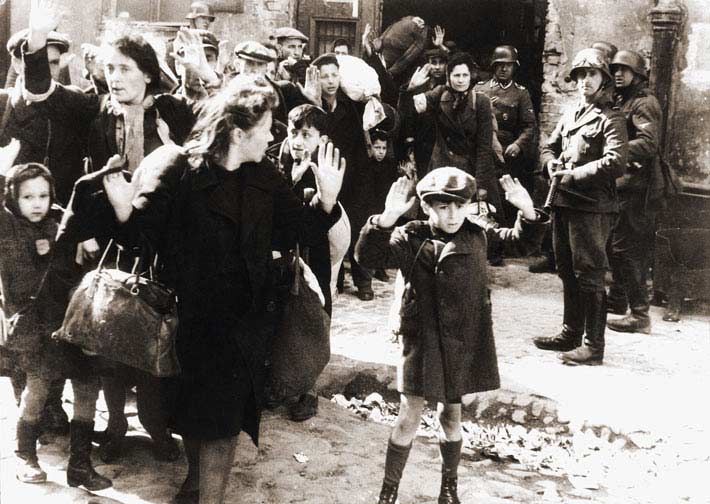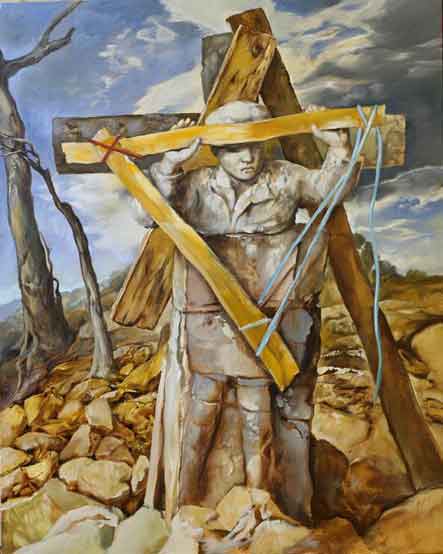The boy with his arms raised in the famous photograph that inspired more than 100 of Samuel Bak’s paintings could easily have been the artist himself.
"I was his age and I looked exactly like him," Bak writes of the boy from the Warsaw ghetto whose haunting photograph became an icon of the Holocaust.
Bak, who will visit Wabash March 2 to open a five-week-long exhibit of his work in the Eric Dean Gallery of the Fine Arts Center, was imprisoned in the Vilna Ghetto in Poland with his mother when he was eight years old. Later they were sent to the same labor camp as his father, Jonas, and Samuel escaped death only after his father smuggled him out of the camp in a bag of sawdust. He was hidden in a Benedictine convent as 250 other children were killed at the camp. Jonas was shot along with the camp’s other laborers ten days before the liberation of Vilna.
 "To me, the boy from Warsaw is the Jewish Crucifixion," Bak writes of this child who represents more than one million children murdered in the Holocaust. He is much more than a symbol to Bak, who has included the Warsaw boy in so many of his works.
"To me, the boy from Warsaw is the Jewish Crucifixion," Bak writes of this child who represents more than one million children murdered in the Holocaust. He is much more than a symbol to Bak, who has included the Warsaw boy in so many of his works.
"Whenever I look at these paintings I see in them my closest childhood friend, Samek Epstein," Bak writes. "We were born the same year, and we both bore the same diminutive of the Hebrew name Shmuel, or Samuel, which in Polish became Samek.
"In 1941, during the Nazi occupation of Vilna, the Lithuanian police discovered the eight-year-old Samek hiding in the home of a Christian woman. They dragged him to the courtyard and shot him. His body was left for hours in a puddle of blood as a warning to any other Jews who might try to remain outside the Ghetto."
"Is it vain of me to hope that through my art I can somehow live now for the two of us, for Samek and for myself, and that in this way his obliterated future will not have been totally lost?" Bak asks.
Novelist and social critic Amos Oz calls him "one of the great painters of the 20th century," but Bak describes himself as "an artist who mostly asks questions and rarely offers answers."
 "His work is entrancing, disquieting," says Wabash Dean of the College Gary Phillips, who with his colleague, Professor of Hebrew Bible Danna Nolan Fewell of the School of Theology at Drew University, has edited Representing the Irreparable: The Shoah, the Bible, and the Art of Samuel Bak, written three catalogs for Bak’s exhibits, and coordinated the upcoming show of the artist’s work at Wabash College.
"His work is entrancing, disquieting," says Wabash Dean of the College Gary Phillips, who with his colleague, Professor of Hebrew Bible Danna Nolan Fewell of the School of Theology at Drew University, has edited Representing the Irreparable: The Shoah, the Bible, and the Art of Samuel Bak, written three catalogs for Bak’s exhibits, and coordinated the upcoming show of the artist’s work at Wabash College.
Bak has exhibited at museums around the world, and Phillips notes that he and Fewell were actually introduced to his work years ago by a student who asked Fewell, ‘Do you know this artist? You should, because he paints the way you read and teach the Bible."
The resulting study of Bak’s work, Phillips says, "has been transformative in the way I think about these Biblical texts, from Genesis to the Apocalypse of John."
Bak’s work challenges convenient or traditional answers of both believers and skeptics to the question, "Why do the innocent suffer?"
"The Jewish philosopher Irving Greenberg has written that, ‘No statement, theological or otherwise, should be made that would not be credible in the presence of burning children,’" Phillips says. Bak’s art keeps those faces in front of us.
The artist’s work also is about teaching and learning, Phillips says, noting the title of Bak’s exhibit at Wabash: "The Art of the Question."
"Bak lives, loves, even obsesses over the questions," Phillips says. "In his work we see suffering that cannot be made right, cannot be repaired, cannot be made meaningful. His paintings ask, ‘How do we bear witness to the truth of suffering and survival? How do we affirm life while at the same time remembering the dead? What work of repair is possible in our own wounded world? What is there left for us to do? Where do we go from here?’"
"Bak refuses to let us retreat undisturbed into academic or religious answers that render us unresponsive to a broken world," Phillips says. "He challenges us to learn and to live out the art of the question."
Questions that began for the artist in Vilna in 1940, and remain in the eyes of the boy in the photograph from the Warsaw ghetto, and in those paintings in which Bak still sees the best friend of his childhood.
"These paintings are intriguing and disquieting, and present a rare and worthwhile opportunity to experience a stunning body of beautifully rendered work," says Wabash Art Gallery Director Michael Atwell. The exhibition has been kindly provided by the Pucker Gallery of Boston, MA.
"The Art of the Question: The Paintings of Samuel Bak," opens March 2 in the Eric Dean Gallery in the Randolph Deer Wing of the Fine Arts Center at Wabash. An opening reception and conversations with Samuel Bak will begin at 5 p.m. and end at 7 p.m.
In photos: Photograph of boy in the Warsaw Ghetto under Nazi occupation, 1943; "With a Blue Thread," one of more than 100 paintings by Samuel Bak based on the "Warsaw Ghetto Boy" photograph. Several of these piece are among paintings in "The Art of the Question: The Paintings of Samuel Bak."